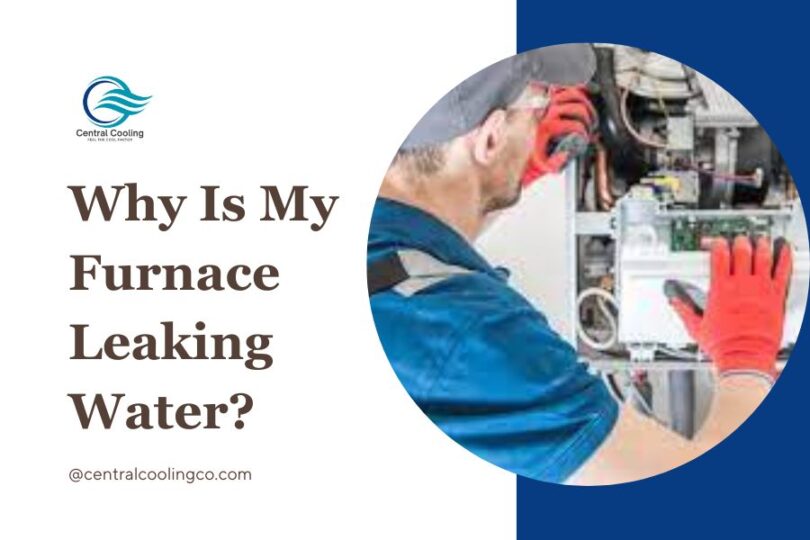Common Causes Of Furnace Water Leaks:
Condensation Leaks:
High-efficiency furnaces produce condensation as a byproduct of the combustion process. If the condensate drain line becomes clogged or damaged, it can result in water leakage. Regular maintenance, including cleaning the drain line, can help prevent this issue.
Humidifier Problems:
If your furnace has a humidifier, it may be the source of the water leak. A malfunctioning humidifier or a faulty water supply line can cause water to leak around the furnace. Inspecting and repairing the humidifier system can resolve this issue.
Blocked Or Disconnected Drain Line:
A blocked or disconnected drain line can cause water to back up and leak from your furnace. Check the drain line for any obstructions or disconnections and clear them if necessary. Regularly cleaning the drain line can prevent clogs from occurring.
Cracked Heat Exchanger:
A cracked heat exchanger can lead to water leakage. This is a serious issue that requires immediate attention from a professional technician. A damaged heat exchanger can also pose safety risks, so addressing this problem promptly is crucial.
Improperly Installed Or Sized Flue Pipe:
If the flue pipe is not correctly installed or is the wrong size, it can cause condensation to form and leak from the furnace. A qualified HVAC technician can inspect the flue pipe and make necessary adjustments or replacements.
If you notice your furnace leaking water, it’s best to contact a licensed HVAC professional to diagnose and resolve the issue. Regular maintenance and inspections can prevent water leaks and ensure your furnace operates efficiently and safely.
Diagnostic Steps For A Leaking Water:
1. Turn Off the Furnace: Before conducting any diagnostic steps, it is essential to turn off the furnace to ensure your safety.
2. Check the Condensate Line: Inspect the condensate line for any signs of blockage or damage. If it is clogged, try clearing it using a small brush or a wet or dry vacuum. If the line is damaged, it may need to be replaced.
3. Examine the Heat Exchanger: Carefully inspect the heat exchanger for any visible cracks or signs of damage. If you notice any issues, it is crucial to contact a professional HVAC technician to assess and repair the heat exchanger.
4. Inspect the Humidifier: If your furnace has a humidifier, check it for any signs of overflowing or leakage. Ensure that the humidifier is properly connected and functioning correctly. Clean or replace any clogged or damaged components as necessary.
5. Check the Flue Pipe: Inspect the flue pipe for any signs of damage or improper installation. Look for cracks, gaps, or loose connections. If you notice any issues, contact a professional to repair or replace the flue pipe.
Preventive Measures And Maintenance Tips:
1. Regular maintenance: Schedule annual maintenance with a qualified HVAC technician to ensure your furnace is properly inspected, cleaned, and maintained. This will help identify and address potential issues before they escalate into major problems.
2. Clean the condensate drain: Regularly inspect and clean the condensate drain to prevent clogs and water backups. Use water and vinegar to flush out any debris or buildup.
3. Inspect and repair drain lines: Check the drain lines for any signs of damage or blockages. If you notice any issues, promptly correct or replace the damaged parts to prevent water leaks.
4. Address humidifier problems: If your furnace has a humidifier, regularly inspect and maintain it to prevent water leaks. Clean or replace the humidifier pad as recommended by the manufacturer.
5. Replace air filters regularly: Follow the manufacturer’s guidelines for replacing or cleaning the air filters. This will ensure proper airflow, preventing the evaporator coil from freezing and causing water leaks.
6. Monitor your furnace: Look for any signs of water leaks, such as puddles or moisture around the furnace. If you notice any leaks, turn off the furnace and contact a professional HVAC technician for assistance.
Read Our Blog: Furnace Gas Leak Symptoms
Frequently Asked Questions:
How Can I Troubleshoot A Leaking Furnace At Home?
Start by checking the condensate drain for blockages, inspecting the heat exchanger for cracks, clearing drain lines, examining the humidifier for malfunctions, and ensuring proper venting. If issues persist, seek professional assistance.
What Should I Do If I Suspect A Cracked Heat Exchanger?
A cracked heat exchanger is a serious issue that requires immediate attention. Turn off the furnace, ventilate the area, and contact a professional HVAC technician for inspection and replacement.
Can A Clogged Drain Line Cause A Furnace To Leak Water?
Yes, a clogged drain line can lead to water accumulation and leaks. Regularly clean the condensate drain and ensure that the drain lines are free of obstructions to maintain proper drainage.
How Often Should I Schedule Maintenance For My Furnace To Prevent Leaks?
It’s advisable to schedule professional maintenance for your furnace at least once a year, ideally before the heating season. Regular inspections and cleaning can help identify and address potential issues, reducing the risk of water leaks.
Conclusion:
Identifying the cause of your furnace water leakage is crucial for maintaining the efficiency and functionality of your heating system. Following the diagnostic steps outlined in this article, you can determine the underlying issue and take appropriate action. However, it is essential to note that some furnace repairs may require the expertise of a professional HVAC technician. If you are unsure or uncomfortable performing any diagnostic steps, it is always best to seek professional assistance.
Remember, regular maintenance and inspections can help prevent furnace water leakage and ensure the longevity of your heating system. If you notice any signs of water leakage or other issues with your furnace, address them promptly to avoid further damage and discomfort in your home.
A leaking furnace not only poses immediate concerns but also can lead to long-term consequences if left unaddressed. Apart from the potential damage to the furnace itself, water leaks can infiltrate various components of your home, such as walls, floors, and ceilings, resulting in structural damage and fostering mold growth, which poses health risks to inhabitants. Moreover, the compromised efficiency of a leaking furnace can lead to increased energy consumption, subsequently reflecting in higher utility bills. Thus, prompt attention to furnace water leaks is essential not only for preserving the integrity of your heating system but also for safeguarding the overall well-being and financial sustainability of your household.
Disclosure: We may get commissions for purchases made through links in this post.








